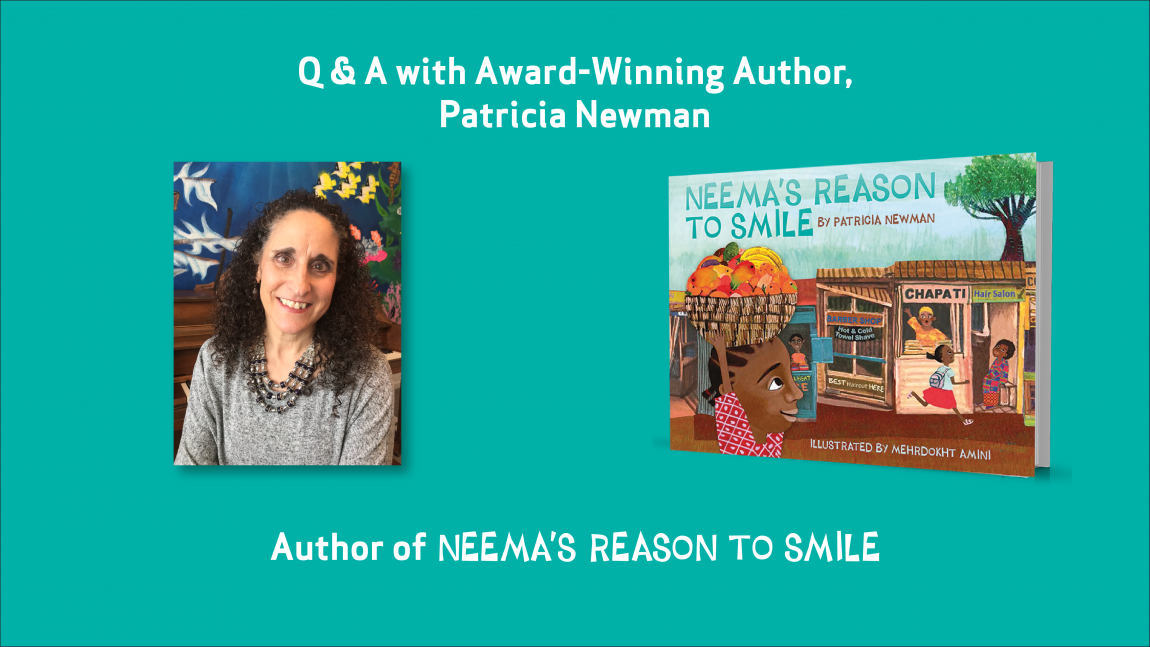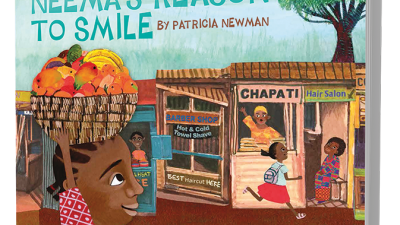Author Patricia Newman and educator Donna Rosenblum team up to respond to a few questions about Neema’s Reason to Smile.
LL: What age range is NEEMA geared toward? Who do you feel this book is written for?
Patricia: The great thing about picture books is they are versatile. Although Neema’s Reason to Smile is rated for ages 4-8, the concepts and themes of the books transcend many ages.
The specific audience is harder to determine because when I write a book, I write for the kid I used to be. The characters and subject have to interest me. Once the book is published, a book spreads its wings and reaches a wider audience.
I know Neema will reach the students at Jambo Jipya School in Kenya, because my friend Donna Rosenblum will share it with them.
It’s been my experience that the book ultimately decides who its audience is. I hope Neema finds its way into the hearts of children who are learning the meaning of compassion and the importance of thinking globally.
LL: You’ve written a number of children’s books mostly on STEM-related topics. What prompted you to write NEEMA?
Patricia: Story ideas come from a lot of different places and there’s no telling which ideas will take root and blossom. The idea for Neema’s Reason to Smile grew out of a phone call with Donna Rosenblum, a librarian from New York. One of my author friends suggested to Donna that I would be a good fit for a project about the power of education. Donna picked up the phone and called me.
She told me about Christine Mwende and the town of Mtwapa, Kenya, where many kids are unable to go to school. Sometimes, they’re too poor to buy the uniforms and supplies. Other times, their parents don’t understand the importance of formal schooling. Christine opened Jambo Jipya School because she believes everyone has the right to learn. She works with the chiefs of many Kenyan tribes to convince families that education is the key to a well-paying job and a better life.
Donna introduced me to Keela Grimmette who used to work at Jambo Jipya School when she was in college. Keela loved the school and the children so much she started an organization to help raise money for food, books, and more modern classrooms. Keela called her organization Reason2Smile (www.reason2smile.org), and Donna now runs it.
The level of passion and commitment of these three women inspired me. Although Neema’s Reason to Smile is a work of fiction, it is based on the real-life students at Jambo Jipya School and their struggle to benefit from a basic right handed to all American children.
LL: Are there any themes in your book you would like readers to learn, change their mind about, be moved by? What do you want readers to remember about your story or characters long after they have finished reading?
Patricia: According to a 2016 Unesco report, 1 in 10 girls are not in school. Neema’s Reason to Smile uses the power of story to help young readers feel what that might feel like for girls such as Neema.
Neema is a bridge builder. It shows we have the power to be kind to one another and that what affects others affects us. In middle-grade STEM titles, such as Zoo Scientists to the Rescue, Sea Otter Heroes and Plastic, Ahoy!, I encourage readers to become the face of change. Even though Neema’s Reason to Smile isn’t a STEM title, it still encourages kids to act.
Perhaps readers will follow Neema’s example and establish a plan to reach an important life goal. Or perhaps readers start a pen pal relationship with an African school or raise money for organizations such as Reason2Smile. Perhaps a U.S. school adopts a sister school in another country.
I trust my readers to find the takeaway that most resonates with them.
LL: Donna, tell us a little about the work Reason2Smile does and the impact they have in helping others.
Reason2Smile Inc, is a 501 (c) 3 registered non-profit corporation whose mission is to help provide educational opportunities for children attending the Jambo Jipya School and Children’s Home in Mtwapa, Kenya with food, clothing and healthcare. We hope to positively impact others and to encourage individuals around the world to be in service to others.
Jambo Jipya was founded in 2004 by Kenyan Christine Mwende and is staffed with Kenyan teachers certified by the Kenyan Education System. Jambo Jipya (meaning “Something New” in Swahili) began with a few mud huts and a handful of students. Today 225 children attend the Jambo Jipya School kindergarten through grade 12. Students pay to attend school but Reason2Smile subsidizes the tuition cost at Jambo Jipya making it much more affordable for families in Mtwapa and the surrounding area. R2S fully supports the orphans who live at the Children’s Home as well as some other special case students.
Reason2Smile has provided students the opportunity to attend trade schools or secure work apprenticeships. Two students have gained university admission and are presently being supported by Reason2Smile.
In the US, I make presentations to schools, libraries, and community groups to help them understand what going to school is like in Kenya. R2S has multiple curriculum trunks (targeted for 3rd grade since they study countries around the world in social studies) filled with lessons, books and Kenya goods that schools can borrow for free. We encourage students to learn about Kenya and then sponsor a fundraiser to support children’s education at the Jambo Jipya school.
LL: What are the key messages in NEEMA you believe are relevant for students today?
- Set goals and have dreams to strive toward.
- With hard work and sacrifice you can achieve your dreams.
- Education is the key to success for all children worldwide. According to an old saying, if you give a man a fish you feed him for a day, but if you teach a man to fish you feed him for a lifetime. Equal access to education is the food that enriches all of our lives.
- Develop Ubuntu, a South African term meaning “I am because we are.” In 2008, Bishop Desmond Tutu explained ubuntu as “the essence of being human. You can’t exist as a human being in isolation. Ubuntu speaks about our interconnectedness. You can’t be human all by yourself, and when you have ubuntu you are known for your generosity. We think of ourselves far too frequently as just individuals, separated from one another, whereas you are connected and what you do affects the whole world.”
LL: What impact do you hope this book makes on children?
Patricia: Many of my books spring from injustices that I see. If a child closes Neema’s Reason to Smile with a warm feeling for Neema’s big heart and her sense of purpose then I’ve accomplished my goal of telling a good story.
But if Neema also taps into a reader’s sense of injustice about equal access to education or an appreciation of another culture, then I feel as if I’ve made an important connection in helping that reader determine what kind of adult s/he’d like to become.
LL: How have your books made a difference in the lives of young readers?
Patricia: In 2017, I received a note from a freshman in college who was studying plastic pollution in the ocean.
“My mom, the librarian at an elementary school, brought home Plastic Ahoy! to help me write [a] research report on plastic pollution. Reading about the scientist’s discoveries and learning about the ocean gyres and how plastic affects the whole food chain inspired me to find out how I could help solve the problem and research it more. But what inspired me the most was seeing that all the scientists were women, showing me that I could have a career in marine science and help research the effect of plastic on marine animals…When I applied to college, I wrote about how this book inspired me to continue researching plastic pollution and changed my career choice. This essay helped me get accepted to UC Berkeley where I am studying Molecular Environmental Biology and hoping to minor in marine science.”
To think that my book (for ages 8-12) inspired the course of this young woman’s career gives me goosebumps. This story is a great example of a book spreading its wings and reaching a wider audience.
LL: In addition to Neema’s Reason to Smile, you also write a lot of nonfiction. What role does nonfiction play in a child’s life?
Patricia: Virtually all of my books are grounded in research—even the fiction titles, such as Neema. But nonfiction can be the gateway to reading for many children—and oftentimes for reluctant readers. Much of the attention in the world of children’s books focuses on fiction, and that’s fine for a child who likes made-up stories. But some kids crave facts. Real life. Photographs. Or a story rooted in fact. These are the kids who will happily tell you everything they know about sea otters or rhinos. When I was kid I loved making connections between what I was learning in school and the world outside my classroom windows. Nonfiction and informational books help kids do that.
And teachers! Science nonfiction is a great way to integrate literacy instruction. As an example, try these four activities that go along with my Sibert Honor-winning title, Sea Otter Heroes: The Predators That Saved an Ecosystem. In each activity, kids are working collaboratively, thinking critically, and using their reading, writing, and listening skills to communicate scientific concepts:
- Draw a sea otter from memory and either list adjectives that describe these fuzzy-faced carnivores or write sea otter poetry.
- Write a skit that demonstrates how the food chain works in Elkhorn Slough. Be sure to include what happens when sea otters disappear from the food chain.
- Like the wolves who restored the balance of the Yellowstone National Park ecosystem, sea otters are part of an important trophic cascade that keeps seagrass ecosystems healthy. Develop your own backyard trophic cascade in a bucket with grass, grasshoppers, and a spider. Write down what happens in a lab notebook.
- Stage a debate about the Endangered Species Act.
LL: We hear you enjoy visiting schools and working with kids. How can a school get you to visit their school?
Patricia: You bet! Simply visit my website and email me with preferred dates.
Related Post
Sibert-Honored Author’s New Picture Book Shares The Power of Female Entrepreneurship and Education


